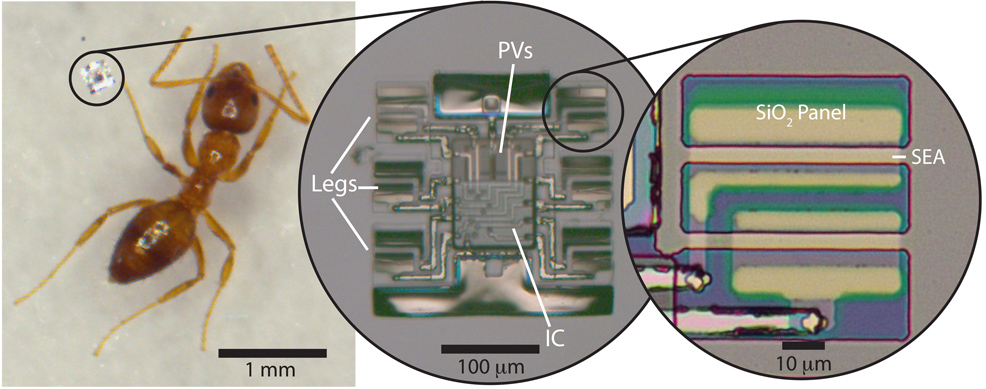
2nd October 2022 Smart microrobots walk autonomously Researchers from Cornell University have installed electronic "brains" on solar-powered robots, so the tiny machines can walk autonomously.
A collaborative effort has succeeded in upgrading solar-powered microbots – each of which now has their own built-in, miniature computer – allowing them to walk autonomously and without being externally controlled. Cornell researchers and others had previously developed microscopic machines able to crawl, swim, walk, and fold themselves up. However, these always had "strings" attached; to generate motion, they needed wires to provide electrical current, or laser beams focused directly onto specific parts of robots. "Before, we literally had to manipulate these 'strings' in order to get any kind of response from the robot," explained Itai Cohen, Professor at Cornell's Department of Physics. "But now that we have these brains on board, it's like taking the strings off the marionette. It's like when Pinocchio gains consciousness." The "brain" in the new robots is a complementary metal-oxide-semiconductor (CMOS) clock circuit, which contains 1,000 transistors, plus an array of diodes, resistors, and capacitors. The integrated CMOS circuit generates a signal that produces a series of phase-shifted, square wave frequencies that in turn set the gait of the robot. The robot legs are ultra-thin (7 nm), platinum-based actuators. Both the circuit and the legs are powered by photovoltaics. "These robots are about 10,000 times smaller by volume than previously demonstrated robots with onboard CMOS electronics," the scientists write in a paper that appears in Science Robotics. "The robot cannot be resolved by the naked eye, appearing only as a bright speck when it scatters light." With overall dimensions of just 100 to 250 micrometres (μm), each machine is smaller than an ant's head. This innovation could enable a new generation of microscopic devices that can track bacteria, sniff out chemicals, destroy pollutants, conduct microsurgery and scrub the plaque out of arteries.
"In some sense, the electronics are very basic," added Cohen. "This clock circuit is not a leap forward in the ability of circuits. But all of the electronics have to be designed to be very low power, so that we didn't have to put humungous photovoltaics to power the circuit." "One of the key parts enabling these robots is that we're using microscale actuators that can be controlled by low voltages and currents," said Alejandro Cortese, PhD, who is CEO of OWiC Technologies, a company he founded to commercialise optical wireless integrated circuits for microsensors. "This is really the first time that we showed that yes, you can integrate that directly into a CMOS process and have all of those legs be directly controlled by effectively one circuit." The team created three versions to demonstrate the CMOS integration: a two-legged "Purcell" bot, named in tribute to physicist Edward Purcell, who proposed a similarly simple model to explain the swimming motions of microorganisms; a more complicated six-legged "antbot", which walks with an alternating tripod gait, like that of an insect; and a four-legged "dogbot" that can vary the speed with which it walks, thanks to a modified circuit. Each can walk at speeds of approximately 10 μm per second. "Eventually, the ability to communicate a command will allow us to give the robot instructions, and the internal brain will figure out how to carry them out," explained Cohen. "Then we're having a conversation with a robot. The robot might tell us something about its environment, and then we might react by telling it, 'OK, go over there and try to suss out what's happening.'" The fabrication process, basically customising foundry-built electronics, has resulted in a platform that could enable other researchers to outfit microscopic robots with their own apps – from chemical detectors to photovoltaic "eyes" that help robots navigate by sensing changes in light. "What this lets you imagine is really complex, highly functional microscopic robots that have a high degree of programmability, integrated with not only actuators, but also sensors," said lead author Michael Reynolds, PhD, who worked with Cortese to design the CMOS brain. "We're excited about the applications in medicine – something that could move around in tissue and identify good cells and kill bad cells – and in environmental remediation, like if you had a robot that knew how to break down pollutants or sense a dangerous chemical and get rid of it." "The real fun part is, just like we never really knew what the iPhone was going to be about until we sent it out into the world, what we're hoping is that now that we've shown the recipe for linking CMOS electronics to robotic actuating limbs, we can unleash this and have people design low-power microchips that can do all sorts of things," Cohen said. "That's the idea of sending it out into the ether and letting people's imaginations run wild."
Comments »
If you enjoyed this article, please consider sharing it:
|







